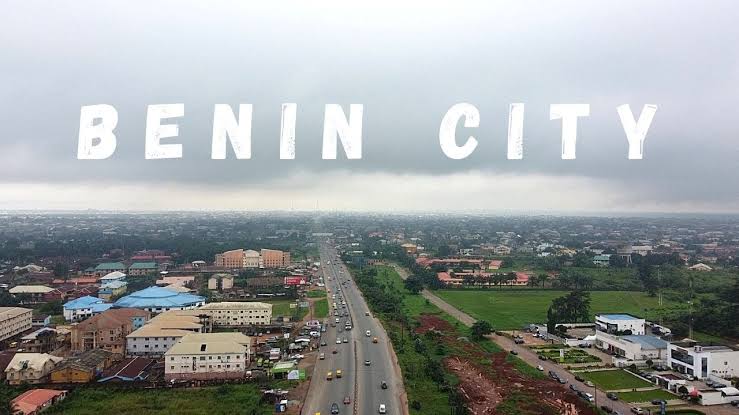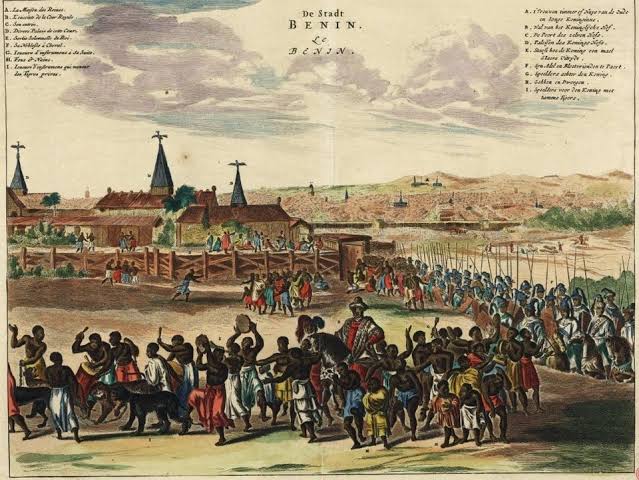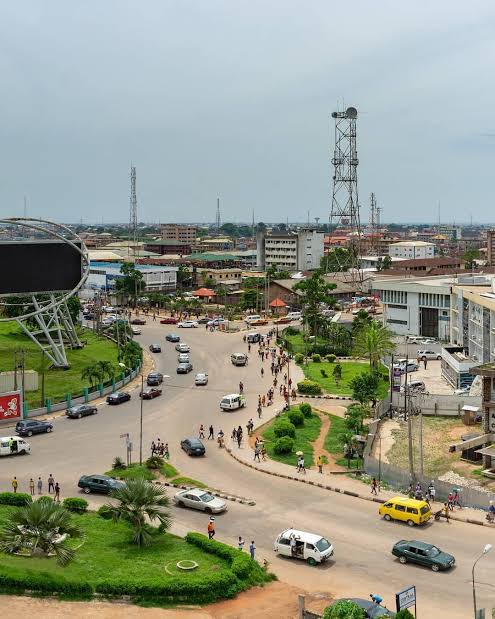Strength and Strategy: How the Kingdom of Benin Engineered a City Before Its Time

INTRODUCTION: The Ancient City Of Benin
“When the Portuguese first visited Benin City in the 15th century, they were stunned and they described it as more orderly civilization.”They astonished the observation of European explorers encountering a civilization that defied every expectation they had of Africa. At a time when many Western cities struggled with structure, and central planning, Benin City stood as a marvel of precision, beauty, and purpose. The Kingdom of Benin, located in present-day Nigeria, was not just a seat of political power, it was a masterpiece of engineering, a model of governance, and a testament to Africa’s ability to innovate independently and intelligently.

Photo Credit: Google Image
With vast walls that stretched farther like the Great Wall of China, an urban grid that was meticulously planned, and art that rivaled the Renaissance in detail and meaning, Benin City was a blueprint of urban sophistication long before such terms even existed in Europe.
The Genius of Benin’s Urban Planning
Long before the modern blueprint of a “smart city” was conceived, Benin City functioned as one. Its infrastructure wasn’t accidental or improvised, it was engineered. At the height of its influence between the 13th and 19th centuries, the capital of the Benin Kingdom boasted a level of urban sophistication that stunned European visitors. Every street, compound, and wall reflected a deliberate vision of order, security, and cultural pride.
At the core of the city’s design were its wide, straight roads, flanked by deep moats and clearly defined districts. Zoning was intentional: areas were allocated for royalty, military officers, bronze casters, traders, and farmers. The city revolved around the Oba’s palace, the spiritual, political, and administrative heartbeat of the kingdom.
But perhaps Benin’s most astonishing feat of engineering was the Great Benin Wall, also knon as rhr Benin moat, a sprawling network of earthworks consisting of deep moats and towering ramparts. Estimated to span over 16,000 kilometers in total length, this ancient defensive system has been called one of the largest human-made structures on Earth, reputed to surpass the length of the Great Wall of China. Its complexity with interconnecting moats, community-specific ramparts, and strategically placed gates demonstrated both architectural intelligence and an advanced understanding of terrain, hydrology, and human movement.
These walls weren’t just for protection; they were tools of social regulation, marking territory, symbolizing status, and creating a visual map of the kingdom’s values. Within these boundaries, every household, guild, and community knew its place, purpose, and duty a physical manifestation of cultural order.
Technological and Political Sophistication
Beyond its physical architecture, Benin’s brilliance lay in how it merged technology with governance. Everything built was a product of calculated design not just to reflect power, but to sustain it. The city’s infrastructure was underpinned by tools, systems, and political structures that made the Benin Kingdom one of precolonial Africa’s most formidable forces.
At the foundation of its construction were blacksmiths who were highly respected members of society, they crafted tools that enabled massive construction efforts, and the production of weapons for defense. But Benin’s mastery of technology wasn’t limited to iron. They were pioneers in architecture, using locally sourced materials like red earth (laterite) and clay to build structures that were both climate-responsive and visually imposing.
The centerpiece of this innovation was the Oba’s Palace a sprawling architectural complex that served as both the political engine and spiritual center of the empire. Designed with inner courtyards, carved pillars, and a hierarchical layout, the palace mirrored the kingdom’s administrative order. From here, the Oba (king) ruled not only as a sovereign but also as a divine figure a living link between the earthly and the ancestral.
This spiritual-political duality gave rise to one of the most effective governance systems in West African history. The Oba was supported by a well-organized hierarchy of chiefs, councilors, guild heads, and village representatives. Each level had clearly defined roles, from managing military campaigns and trade networks to overseeing justice, land distribution, and taxation. Revenue was collected through a structured taxation system, which helped fund public works, festivals, and the arts all without collapsing into chaos or corruption for centuries.
Today, the brilliance of these bronzes is still recognized globally though sadly, many are housed in European museum. Still, the scientific, symbolic, and aesthetic depth of these pieces continues to affirm what the people of Benin always were.
LEGACY IN RUINS: Colonization and the 1897 Invasion
In February 1897, the British Empire launched one of the most infamous acts of imperial violence on African soil, the Benin Punitive Expedition. British forces invaded the Kingdom of Benin with overwhelming firepower, burned the city to the ground, and looted thousands of invaluable artifacts, including intricate Benin Bronzes, carved ivory tusks, ceremonial masks, and palace relics.

Photo Credit: BeninHistory
The invasion did not merely dismantle buildings, The Oba Ovonramwen was deposed and exiled, sacred sites were desecrated, and centuries of carefully preserved tradition were scattered across foreign lands. Today, much of what the world knows of ancient Benin’s grandeur is based on the artifacts taken and displayed in European museums, including the British Museum, the Linden Museum in Germany, and others in Austria, France, and the United States.
These bronzes, originally embedded in palace walls or used in court rituals, were not just art, they were archives of history, symbols of authority, and spiritual links to Benin's ancestors. Their removal was both a physical and psychological colonization.
Yet, even in ruin, Benin City’s genius refused to be buried. Archaeologists, urban planners, and architects continue to study the remnants of its design from its famed earthworks (Iya), which some scholars argue rivaled the Great Wall of China in scale, to the city’s precise layout and functional zoning. The echoes of that lost metropolis have inspired modern African architecture and contributed to rethinking precolonial urban sophistication.
Benin’s Influence on Modern African Urbanism
In today’s fast-evolving African cities, where high-rise buildings jostle for space with informal markets, and blueprints often clash with local realities, a quiet revolution is taking shape. Across the continent, urban designers, architects, and cultural theorists are turning their gaze inward, seeking inspiration from the deep well of indigenous African urban legacies. And among the most frequently cited models is Benin City, not just as a historical marvel, but as a living blueprint for what African cities could become.
Modern African urbanists are beginning to see Benin City for what it truly was: a sustainable, organized, and community-centric city that integrated nature, culture, and governance. Its layout respected natural topography. Its construction materials were environmentally friendly. Its zoning promoted harmony between public life, spiritual practice, and residential intimacy. These values are exactly what contemporary African city-builders are rediscovering in the face of rapid, often chaotic urbanization.
Architects like Kunlé Adeyemi (founder of NLÉ and designer of the Makoko Floating School in Lagos) and Tosin Oshinowo, known for her Afro-modernist approach, are at the forefront of a movement that insists that Africa’s future doesn’t have to mimic Dubai or Paris, it can reflect Lagos, Addis Ababa, or Accra as they’ve always been: culturally intelligent, spiritually aware, and ecologically grounded. Their work echoes the philosophy behind Benin’s structure, a belief that space is not just functional but symbolic and sacred.
This shift is also deeply tied to the rise of Afrofuturism, a cultural aesthetic that blends African heritage with futuristic vision. Within this lens, Benin is more than a past empire, it’s a prototype for reimagining African futures.
Benin City’s legacy, then, is not buried in the past. It lives on in the aspirations of young African architects who are using traditional planning methods to shape the present, It breathes in every conversation that asks, “What would an African city look like if African philosophies of living, relating, and building were still in place?”
CONCLUSION: Looking Forward Through the Past
Benin City wasn’t just advanced for its time, it was timeless. With its deliberate planning, sustainable design, political intelligence, and technological artistry, the ancient city represents not just what Africa once was, but what it still has the capacity to become.

Photo Credit: Google Image
In a world racing toward innovation, history tells another story., Africa has long been Innovating, it's earthworks, bronze records, communal planning, and spiritually infused urbanism are not fragments of a forgotten age, they are clues to a well organized, inclusive, and culturally rooted past and future. If the continent is to reclaim its place as a leader in innovation and resilience, the blueprint doesn’t have to be invented from scratch. It’s already here , embedded in our soil, etched in our memory, cast in our bronzes.
So the next time we look outward for solutions, maybe we should look inward instead, to the legacy of a city that proved African genius was always here.
Africa doesn’t need to borrow blueprints — it just needs to dust off its own.
You may also like...
Super Eagles' Shocking Defeat: Egypt Sinks Nigeria 2-1 in AFCON 2025 Warm-Up

Nigeria's Super Eagles suffered a 2-1 defeat to Egypt in their only preparatory friendly for the 2025 Africa Cup of Nati...
Knicks Reign Supreme! New York Defeats Spurs to Claim Coveted 2025 NBA Cup

The New York Knicks secured the 2025 Emirates NBA Cup title with a 124-113 comeback victory over the San Antonio Spurs i...
Warner Bros. Discovery's Acquisition Saga: Paramount Deal Hits Rocky Shores Amid Rival Bids!

Hollywood's intense studio battle for Warner Bros. Discovery concluded as the WBD board formally rejected Paramount Skyd...
Music World Mourns: Beloved DJ Warras Brutally Murdered in Johannesburg

DJ Warras, also known as Warrick Stock, was fatally shot in Johannesburg's CBD, adding to a concerning string of murders...
Palm Royale Showrunner Dishes on 'Much Darker' Season 2 Death

"Palm Royale" Season 2, Episode 6, introduces a shocking twin twist, with Kristen Wiig playing both Maxine and her long-...
World Cup Fiasco: DR Congo Faces Eligibility Probe, Sparks 'Back Door' Accusations from Nigeria

The NFF has petitioned FIFA over DR Congo's alleged use of ineligible players in the 2026 World Cup playoffs, potentiall...
Trump's Travel Ban Fallout: African Nations Hit Hard by US Restrictions

The Trump administration has significantly expanded its travel restrictions, imposing new partial bans on countries like...
Shocking Oversight: Super-Fit Runner Dies After Heart Attack Symptoms Dismissed as Heartburn

The family of Kristian Hudson, a 'super-fit' 42-year-old marathon runner, is seeking accountability from NHS staff after...
.png&w=1920&q=75)






